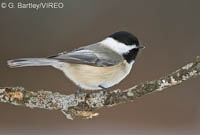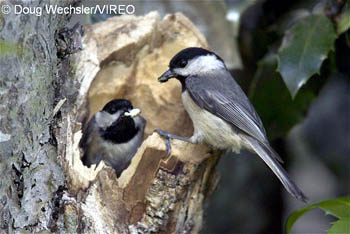Loading ...
Carolina Chickadee
Carolina Chickadees (Poecile carolinensis) are year-round residents across the southeastern United States from Florida north to Pennsylvania and west to Texas. This chickadee, like its northern counterpart, the Black-capped Chickadee (below), is most often seen at bird feeders and in winter flocks, which can include nuthatches, titmice, and downy woodpeckers. Chickadees are well known for their active, acrobatic behavior and their "chick-a-dee, dee, dee" call. In spring and summer the males sing a clear, typically four-noted whistle ("see-bee, see-bay"), the second and fourth notes lower in pitch than first and second (in contrast to the single pair of notes ("fee-bee") of the Black-capped). Chickadees have the ability to regulate body temperature to conserve energy in very cold conditions. They lower the temperature at night by 10 degrees Fahrenheit.. Chickadees possess an excellent spatial memory: they store seeds in tree bark and conifer needles and can locate the caches a month later.
See all Carolina Chickadee photosField Marks:
Chickadees are easily identified by their small body size, black cap and throat, and white cheeks. The sexes are alike. (L.4.75 in.)
Distribution:
Southeastern U.S. north to Pennsylvania and west to Texas, except that the Black-capped Chickadee replaces the Carolina at higher elevations in the Appalachian Mountains.
Similar Species:
 |
Black-capped Chickadee (species account) (all photos) The Black-capped Chickadee is the northern U.S. counterpart of the Carolina Chickadee, and in the limited region where the two species overlap, an experienced observer can distinguish the Carolina by the less pronounced white edges on its wing-covering feathers (coverts) and its proportionately shorter tail. |
Habitat & Nesting:
The Carolina Chickadee inhabits open deciduous forests and woodland edges. It nests in tree cavities and nest boxes with an entrance hole of 1-1.25 in., an average of 8 feet above the ground. The male-female pair bond can extend for several years.
More Information:
Chickadees change their diet from 50 percent seeds and berries in the winter to 10-20 percent in the breeding season, with the remainder consisting of insects (mostly caterpillars) and spiders. Chickadees are preyed upon by Sharp-shinned Hawks, raccoons and squirrels.

